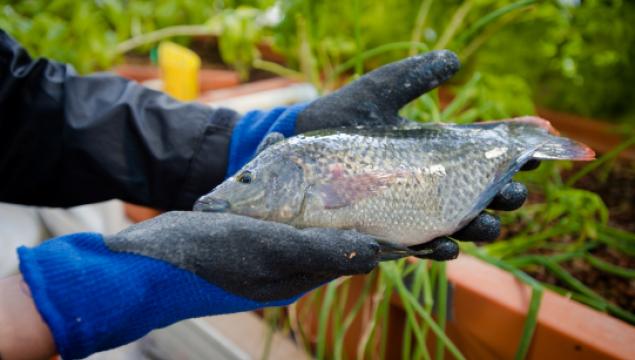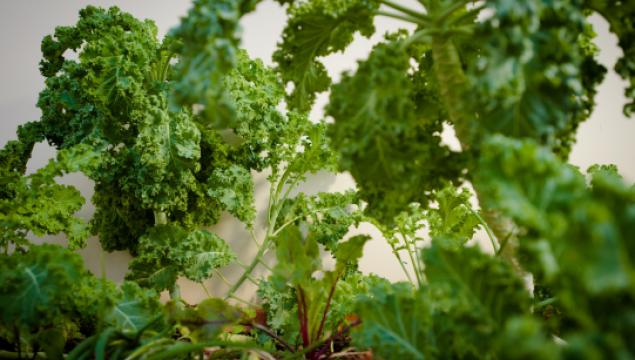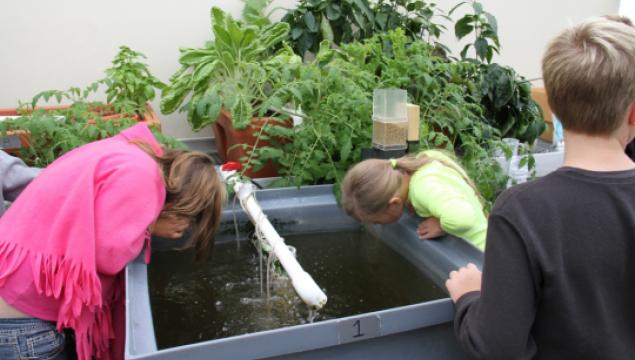Aquaponics for Research and Education at Michigan Technological University
Why This Project Is Important
Researchers at Michigan Tech have been operating an aquaponics system in the Dow campus greenhouse for the past 18 months. The system has been a great science, technology, engineering, and mathematics (STEM) teaching tool for over 1,500 K-12 students, college student, and community members. It is a wonderful example of ecosystem function, sustainable agriculture, and engineering design concepts, and students are captivated by the interconnected nature of the processes. With funding from Superior Ideas, we can continue and expand on the success of this project.
Project Description
Statement of Purpose
With funding from Superior Ideas, the aquaponics system at Michigan Tech can continue to serve as a multidisciplinary research and education tool for the entire community, while expanding our efforts to study the impacts of these systems on our local food network. The campus community benefits from demonstration of a unique engineered system in the heart of campus, and several classes, student groups, and educational outreach efforts regularly make use of the system. The system is operated and maintained by project personnel, with assistance from the many student groups that are engaged in the aquaponics educational initiatives as well as student volunteers. Proceeds from our Superior Ideas funding will allow us to compensate student operators of the aquaponics system and provide them with more formal training on aquaponics concepts. We will also be able to fund purchases of new fingerling fish, supplies to maintain the system, and research space within the Michigan Tech greenhouses and lab facilities. If the fundraising effort is successful, we will also begin designing an expanded system with increased capabilities, to offer more research and educational possibilities to the wider community.
Aquaponics Overview
Aquaponics is a term to describe the integration of aquaculture (fish farming) with hydroponics (growing plants without soil) in a closed-loop, mutually-supporting system. Fish wastes provide fertilizer for plant growth, while the plants filter and clean water to maintain a healthy environment for the fish. Several important bacterial species are involved to convert ammonia present in fish waste to nitrate, a form of nitrogen that plants can use, and mediate other important reactions in the system(1). These concepts are not new and have long been put to use in some settings, such as stocking flooded rice patties with tilapia. Improved technology and a resurgence of interest in the field has spawned a new wave of engineered systems in recent years, focusing on optimizing the interactions of fish and plants through improved aeration, efficient water movement, feed management, and nutrient cycling. Many different fish species are used for specific applications, depending on project requirements for water temperature, fish feed availability, and stocking density. Plants of all varieties have been grown successfully in aquaponics, with a greater focus on high-value vegetables and herbs in commercial systems.
Aquaponics on the Michigan Tech Campus
The Michigan Tech Department of Biological Sciences multiple greenhouses on campus, and the current aquaponics system is housed in the greenhouse space on the 9th floor of the Dow Environmental Sciences and Engineering Building. The greenhouse is equipped with water, electrical service, and is connected to campus heating and cooling systems. Our current aquaponics system consists of two units that can operate independently for control and experimental trials. Each system has a 150-gallon fish tank and three 2 x 3 ft media-filled biofilter/growing beds for plant growth. We have successfully raised tilapia from inch-long fingerlings to 1.5-lb fish, and in the process we have produced several hundred pounds of produce, including basil, beets, bok choy, broccoli, cucumbers, eggplant, jalapenos, kale, onions, spinach, tomatoes, and zucchini. Dr. Handler from the Sustainable Futures Institute (SFI) has maintained the aquaponics system, with the assistance of student volunteers and student groups using the system. The system has been a great tool for education and outreach in communicating water, agriculture, and sustainability issues to people of all ages, as over 1,500 people have toured the system during its 18 months of operation.
Project Significance
Agriculture and related practices are prominent drivers in environmental issues across developed and developing regions of the world, as societies intensify production systems in response to increasing population and development pressures. For example, in the U.S., fresh water use to support agriculture accounts for roughly 80% of demand(2), and regional scarcity of macronutrient fertilizers place undue stress on agricultural operations in developing regions(3). Engineered aquaponics systems have emerged in response to these challenges, and have sparked serious interest in many parts of the world due to potential environmental, economic, and social benefits. Recirculating systems use less water than conventional agriculture or aquaculture systems on the basis of goods produced, and solve pollution problems arising from aquaculture while reducing fertilizer requirements for soil-less agriculture(4). Both plants and fish can be produced in a system, adding another source of revenue to conventional aquaculture or hydroponics alone, while the additional cost of filtration equipment or fertilizers are greatly reduced. In areas where good soil is not in abundance or in urban settings, aquaponics has been investigated as a means of locally-grown sustenance for a community, and community-based aquaponics projects have been spreading throughout the country, even in the colder Great Lakes region (e.g., Victus Farm in Silver bay, MN, and Growing Power in Milwaukee, WI)(5,6). Aquaponics systems have been installed in universities around the U.S. as tools to examine the potential benefits of this technology, but also to illustrate a variety of science, technology, engineering, and mathematics (STEM) concepts. Properly functioning aquaponics systems seem simple, but a great deal of biological and chemical activity is occurring in a thoughtfully-engineered system, resulting in many teachable moments and illustrative scenarios for students in a variety of disciplines.
References
1 – J.E. Rakocy, M.P. Masser, T.M. Losordo. 2006. Southern Regional Aquaculture Center, No. 454. 1
2 – United States Dept of Agriculture, Economic Research Service. 2004. http://www.ers.usda.gov/Briefing/WaterUse/
3 – I. El-dukheri, N. Elamin, et al. 2011. Food Security, SI-1, S149-S162.
4 – R.V. Tyson, D.D. Treadwell, E.H. Simonne. 2011. Horticultural Technology, v21(1), 6-13.
5 – Victus Farm, www.d.umn.edu/cscd/victusfarm
6 – Sweet Water Organics, Inc., http://sweetwater-organic.com
7 – Growing Power, Inc., http://www.growingpower.org
Meet the Researchers

Robert Handler
I work at Michigan Tech, as the Operations Manager for the Michigan Tech Sustainable Futures Institute. We organize sustainability-themed research and education projects that involve faculty and students from all across campus to look at issues related to energy, materials/manufacturing, international development, and complex systems. Before coming to Michigan Tech, I went to graduate school at the University of Iowa, where I earned a PhD in Environmental Engineering.

days left
funded
last
What Your Donation Can Help Us Do:
- Purchase supplies (fingerling fish, fish food, water quality testing, etc.)
- Compensate student volunteer system operators
- Fund formal aquaponics training for student groups
- Pay for greenhouse and laboratory space
- Expand current aquaponics system to test new designs
Recent Donors
Some donors may be hidden.






 Gifts to projects listed on SUPERIORIDEAS.ORG are received and processed by Michigan Tech Fund. Michigan Tech Fund is a tax-exempt organization under Section 501(c)(3) of the Internal Revenue Code acting on behalf of Michigan Technological University. It is the policy of Michigan Tech Fund that a portion of the gifts and/or income therefrom may be used to defray the costs of raising and administering the funds.
Gifts to projects listed on SUPERIORIDEAS.ORG are received and processed by Michigan Tech Fund. Michigan Tech Fund is a tax-exempt organization under Section 501(c)(3) of the Internal Revenue Code acting on behalf of Michigan Technological University. It is the policy of Michigan Tech Fund that a portion of the gifts and/or income therefrom may be used to defray the costs of raising and administering the funds.
Questions for the Researcher